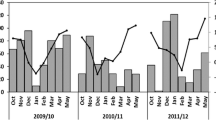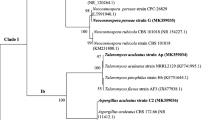Abstract
Several species of fungi and oomycetes including Fusarium, Rhizoctonia, Phytophthora and Pythium have been reported as root pathogens of apple where they contribute to a phenomenon known as apple replant disease. In South Africa, little is known about specific species in these genera and their pathogenicity toward apple. Therefore, these aspects were investigated along with the development and optimization of qPCR tests for detection and quantification of the most virulent oomycete species. In eight investigated orchards, the oomycete Phythophthora cactorum was widely distributed, while nine Pythium species were differentially distributed among the orchards. Pythium irregulare was the most widely distributed and the most virulent species along with P. sylvaticum, P. vexans and Ph. cactorum. Seven binucleate Rhizoctonia anastomosis groups (AGs) were also differentially distributed among the orchards, with the majority appearing to be non-pathogenic while certain AG-I and AG-F isolates exhibited low virulence on apple. In the genus Fusarium, F. oxysporum was widely distributed, but isolates were non-pathogenic. Fusarium solani and F. avenaceum were less frequently encountered, with only some isolates having low virulence. qPCR data obtained from seedling roots inoculated with the most virulent Pythium species (P. irregulare, P. sylvaticum and P. vexans) and the genus Phytophthora were not always reproducible between trials, or isolates of the same species. In general, seedling growth inhibition was associated with the presence of a low amount of pathogen DNA (±40 fg μl−1 to 2 pg μl−1) in roots. Pythium irregulare, although having the lowest DNA concentrations in roots, was the only species for which a significant negative correlation was found between seedling weight and pathogen DNA concentration.



Similar content being viewed by others
Abbreviations
- AG:
-
anastomosis group
- qPCR:
-
quantitative real-time PCR
References
Bent, E., Loffredo, A., Yang, J.-I., McKenry, M. V., Becker, J. O., & Borneman, J. (2009). Investigations into peach seedling stunting caused by a replant soil. FEMS Microbiology Ecology, 68, 192–200.
Bustin, S. A., Benes, V., Garson, J. A., Hellemans, J., Huggett, J., Kubista, M., et al. (2009). The MIQE Guidelines: minimum information for publication of quantitative real-time PCR experiments. Clinical Chemistry, 55, 611–622.
Carling, D. E., Kuninaga, S., & Brainard, K. A. (2002). Hyphal anastomosis reactions, rDNA-internal transcribed spacer sequences, and virulence levels among subsets of Rhizoctonia solani anastomosis group-2 (AG-2) and AG-BI. Phytopathology, 92, 43–50.
Cook, R. J., Sitton, J. W., & Haglund, W. A. (1987). Influence of soil treatments on growth and yield of wheat and implications for control of Pythium root rot. Phytopathology, 77, 1192–1198.
Cooke, D. E. L., & Duncan, J. M. (1997). Phylogenetic analysis of Phytophthora species based on the ITS1 and ITS2 sequences of ribosomal DNA. Mycological Research, 101, 667–677.
Cooke, D. E. L., Schena, L., & Cacciola, S. O. (2007). Tools to detect, identify and monitor Phytophthora species in natural exoystems. Journal of Plant Pathology, 89, 13–28.
Dick, M. W. (1990). Key to Pythium (pp. 1–64). Reading: Department of Botany, University of Reading, Reading Press.
Dick, M. W. (2001a). The peronosporomycetes. In D. J. McLaughlin, E. G. Mclaughlin, & P. A. Lemke (Eds.), The Mycota VII Part A. Systematics and evolution (pp. 39–72). Germany: Springer.
Dick, M. W. (2001b). Straminipilious fungi: systematics of the peronosporomycetes, including accounts of the marine straminipilous protests, the plasmodiophorids, and similar organisms. Dordrecht, The Netherlands: Kluwer Academic Publishers.
Dullahide, S. R., Stirling, G. R., Nikulin, A., & Stirling, A. M. (1994). The role of nematodes, fungi, bacteria, and abiotic factors in the etiology of apple replant problems in the Granite Belt of Queensland. Australian Journal of Experimental Agriculture, 34, 1177–1182.
Erwin, D. C., & Ribeiro, O. K. (1996). Phytophthora diseases worldwide. St. Paul: The American Phytopathological Society Press.
Fravel, D., Olivain, C., & Alabouvette, C. (2003). Fusarium oxysporum and its biocontrol. New Phytologist, 157, 493–502.
Geiser, D. M., Jimenez-Gasco, M. M., Kang, S., Makalowska, I., Veeraraghavan, N., Ward, T. J., et al. (2004). Fusarium-ID v. 1.0: A DNA sequence database for identifying Fusarium. European Journal of Plant Pathology, 110, 473–479.
Glass, G. V., Peckham, P. D., & Sanders, J. R. (1972). Consequences of failure to meet assumptions underlying the fixed effects analyses of variance and covariance. Review of Educational Research, 42, 237–288.
Goud, J. C., & Termorshuizen, A. J. (2003). Quality of methods to quantify microsclerotia of Verticillium dahliae in soil. European Journal of Plant Pathology, 109, 523–534.
Jeffers, S. N., & Martin, S. B. (1986). Comparison of two media selective for Phytophthora and Pythium species. Plant Disease, 70, 1038–1043.
Jeffers, S. N., & Wilcox, W. F. (1990). Phytophthora crown, collar, and root rots. In A. L. Jones & H. S. Aldwinckle (Eds.), Compendium of apple and pear diseases (pp. 43–45). St. Paul: The American Phytopathological Society.
Jeffers, S. N., Aldwinckle, H. S., Burr, T. J., & Arneson, P. A. (1982). Phytophthora and Pythium species associated with crown rot in New York apple orchards. Phytopathology, 72, 533–538.
John, J. A., & Quenouille, M. H. (1977). Experiments: Design and analysis (pp. 232–248). England: Charles Griffin & Co Ltd.
Kannwischer, M. E., & Mitchell, D. J. (1978). The influence of a fungicide on the epidemiology of black shank of tobacco. Phytopathology, 68, 1760–1765.
Lamprecht, S. C. (1986). A new disease of Medicago truncatula caused by Cylindrocladium scoparium. Phytophylactica, 18, 111–114.
Lee, S. B., & Taylor, J. W. (1990). Isolation of DNA from fungal mycelia and single spores. In M. A. Inni, D. H. Gelfand, J. J. Sninsky, & T. J. White (Eds.), PCR protocols: A guide to methods and applications (pp. 282–287). San Diego: Academic.
Leslie, J. F., & Summerell, B. A. (2006). The Fusarium laboratory manual (p. 388). Oxford, UK: Blackwell Publishing Ltd.
Levene, H. (1960). Robust test in the equality of variance. In Iolkin Palo Alto (Ed.), Contributions to probability and statistics (pp. 278–292). California, USA: Stanford University Press.
Lévesque, C. A., & De Cock, A. W. A. M. (2004). Molecular phylogeny and taxonomy of the genus Pythium. Mycological Research, 108, 1363–1388.
Manici, L. M., Ciavatta, C., Kelderer, M., & Erschbaumer, G. (2003). Replant problems in South Tyrol: role of fungal pathogens and microbial population in conventional and organic apple orchards. Plant and Soil, 256, 315–324.
Mantiri, F., Samuels, G. J., Rahe, J. E., & Honda, B. M. (2001). Phylogenetic relationships in Neonectria species having Cylindrocarpon anamorphs inferred from mitochondrial ribosomal DNA sequences. Canadian Journal of Botany, 79, 334–340.
Mazzola, M. (1997). Identification and pathogenicity of Rhizoctonia spp. isolated from apple roots and orchard soils. Phytopathology, 87, 582–587.
Mazzola, M. (1998). Elucidation of the microbial complex having a causal role in the development of apple replant disease in Washington. Phytopathology, 88, 930–938.
Mazzola, M. (1999). Transformation of soil microbial community structure and Rhizoctonia suppressive potential in response to apple roots. Phytopathology, 89, 920–927.
Mazzola, M., Andrews, P. K., Reganold, J. P., & Lévesque, C. A. (2002). Frequency, virulence, and metalaxyl sensitivity of Pythium spp. isolated from apple roots under conventional and organic production systems. Plant Disease, 86, 669–675.
McLeod, A., Botha, W. J., Meitz, J. C., Spies, C. F. J., Tewoldemedhin, Y. T., & Mostert, L. (2009). Morphological and phylogenetic analyses of Pythium species in South Africa. Mycological Research, 113, 933–951.
Miller, P. (1955). V-8 juice agar as a general purpose medium for fungi and bacteria. Phytopathology, 45, 461–462.
O’Donnell, K., Kistler, H. C., Cigelnik, E., & Ploetz, R. C. (1998). Multiple evolutionary origins of the fungus causing Panama disease of banana: concordant evidence from nuclear and mitochondrial gene genealogies. Proceedings of the National Academy of Sciences, 95, 2044–2049.
Otto, R. L. (1998). An introduction to statistical methods and data analyses. Belmont: Duxbury Press. 105 pp.
Picard, K., Ponchet, M., Blein, J. P., Rey, P., Tirilly, Y., & Benhamou, N. (2000). Oligandrin. A proteinaceous molecule produced by the mycoparasite Pythium oligandrum induces resistance to Phytophthora parasitica infection in tomato plants. Plant Physiology, 124, 379–395.
SAS. (1999). SAS/STAT user’s guide. Version 8, vol 2. SAS Campus Drive, North Carolina 27513, USA: SAS Institute Inc.
Schena, L., Hughes, K. J. D., & Cooke, D. E. L. (2006). Detection and quantification of Phytophthora ramorum, P. kernoviae, P. citricola and P. quercina in symptomatic leaves by multiplex real-time PCR. Molecular Plant Pathology, 7, 365–379.
Schena, L., Nigro, F., Ippolito, A., & Gallitelli, D. (2004). Real-time quantitative PCR: a new technology to detect and study phytopathogenic and antagonistic fungi. European Journal of Plant Pathology, 110, 893–908.
Schena, L., Duncan, J. M., & Cooke, D. E. L. (2008). Development and application of a PCR-based ‘molecular tool box’ for the identification of Phytophthora species damaging forests and natural ecosystems. Plant Pathology, 57, 64–75.
Schroeder, K. L., Okubara, P. A., Tambong, J. T., Lévesque, C. A., & Paulitz, T. C. (2006). Identification and quantification of pathogenic Pythium spp. from soils in eastern Washington using real-time polymerase chain reaction. Phytopathology, 96, 637–647.
Sewell, G. W. F. (1981). Effects of Pythium species on the growth of apple and their possible causal role in apple replant disease. Annals of Applied Biology, 97, 31–42.
Shapiro, S. S., & Wilk, M. B. (1965). An analysis of variance test for normality (complete samples). Biometrika, 52, 591–611.
Singleton, L. L., Mihail, J. D., & Rush, C. M. (1992). Methods for research on soilborne phytopathogenic fungi. St. Paul, MN, USA: American Phytopathological Society Press.
Sneh, B., Zeidan, M., Ichielevich-Auster, M., Barash, I., & Koltin, Y. (1986). Increased growth responses induced by a nonpathogenic Rhizoctonia solani. Canadian Journal of Botany, 64, 2372–2378.
Sneh, B., Burpee, L., & Ogoshi, A. (1991). Identification of Rhizoctonia species. St. Paul: American Phytopathological Society Press.
Spies, C. F. J. (2010). Characterisation and detection of Pythium and Phytophthora species associated with grapevines in South Africa. PhD thesis, University of Stellenbosch, South Africa.
Strauss, J., & Labuschagne, N. (1995). Pathogenicity of Fusarium solani isolates on citrus roots and evaluation of different inoculum types. Toegepaste Plantwetenskap, 9, 48–52.
Sutton, D. A., Fothergill, A. W., & Rinaldi, M. G. (Eds.). (1998). Guide to clinically significant fungi (1st ed.). Baltimore: Williams & Wilkins.
Tewoldemedhin, Y. T., Mazzola, M., Mostert, L., & McLeod, A. (2010). Cylindrocarpon species associated with apple tree roots in South Africa and their quantification using real-time PCR. European Journal of Plant Pathology. doi:10.1007/s10658-010-9728-4.
Van Schoor, L., Denman, S., & Cook, N. C. (2009). Characterisation of apple replant disease under South African conditions and potential biological management strategies. Scientia Horticulturae, 119, 153–162.
White, T. J., Bruns, T., Lee, S., & Taylor, J. (1990). Amplification and direct sequencing of fungal ribosomal RNA genes for phylogenetics. In M. A. Innis, D. H. Gelfand, J. J. Sninsky, & T. J. White (Eds.), PCR protocols, a guide to methods and applications (pp. 315–322). San Diego: Academic.
Yamamoto, D. T., & Uchida, J. Y. (1982). Rapid nuclear staining of Rhizoctonia solani and related fungi with Acridine orange and with Safranin O. Mycologia, 74, 145–149.
Zondo, P. T., Denman, S., & Labuschagne, I. F. (2007). Effect of season and aggressiveness of isolates on the response of two apple rootstocks to Phytophthora cactorum infection. Australasian Plant Pathology, 36, 240–244.
Author information
Authors and Affiliations
Corresponding author
Rights and permissions
About this article
Cite this article
Tewoldemedhin, Y.T., Mazzola, M., Botha, W.J. et al. Characterization of fungi (Fusarium and Rhizoctonia) and oomycetes (Phytophthora and Pythium) associated with apple orchards in South Africa. Eur J Plant Pathol 130, 215–229 (2011). https://doi.org/10.1007/s10658-011-9747-9
Accepted:
Published:
Issue Date:
DOI: https://doi.org/10.1007/s10658-011-9747-9




